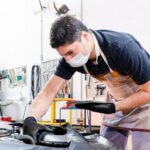Thinking of sprucing up your car with a fresh coat of paint? Whether you’re restoring a classic car, repairing scratches, or customizing your ride, choosing the right automotive paint supplies is crucial. With so many products on the market, it can feel overwhelming to know where to start. But don’t worry—we’re here to steer you in the right direction!
In this guide, we’ll cover the essentials of automotive paint supplies, break down the types of paints and tools you’ll need, and provide expert tips to get professional-quality results, even if you’re a first-timer.
What Are Automotive Paint Supplies?
Automotive paint supplies encompass all the materials, tools, and products needed for painting or refinishing a vehicle. From the prep work to the finishing touches, these supplies are essential for achieving a durable and visually appealing finish.
Common Automotive Paint Supplies Include:
- Primers: Used to prepare the surface for paint and improve adhesion.
- Basecoats: Provide the main color layer.
- Clear Coats: Protect the basecoat and add a glossy finish.
- Thinners and Reducers: Adjust the paint’s consistency for spraying.
- Sandpaper and Abrasives: Smooth surfaces before painting.
- Spray Guns and Air Compressors: Essential for applying paint evenly.
Types of Automotive Paints
When it comes to automotive paints, you’ve got options. Each type serves a unique purpose and offers varying levels of durability, finish, and ease of application.
1. Acrylic Lacquer
- Known for its glossy finish and vibrant colors.
- Easy to apply but less durable compared to modern options.
2. Acrylic Enamel
- Provides a harder finish, making it more durable than lacquer.
- Often used for single-stage painting systems.
3. Urethane Paints
- Extremely durable and resistant to fading or chipping.
- Requires more experience to apply but offers a professional-grade finish.
4. Waterborne Paints
- Eco-friendly and gaining popularity in professional shops.
- Offers excellent coverage and is easy to clean up.
Essential Tools for Automotive Painting
Before you start your project, ensure you’ve got these tools in your arsenal:
- Spray Gun: Vital for even paint application. Opt for an HVLP (High Volume Low Pressure) gun for the best results.
- Air Compressor: Supplies the power needed for spray guns.
- Masking Tape and Plastic Sheeting: Protect parts of the vehicle you don’t want painted.
- Respirator Mask: Keeps harmful fumes at bay—don’t skip this!
- Mixing Cups and Sticks: Ensures accurate ratios of paint, hardeners, and thinners.
Steps to Paint Your Vehicle
Step 1: Prepare the Surface
- Wash the car thoroughly to remove dirt and grease.
- Sand the surface using grit sandpaper to ensure proper adhesion.
Step 2: Apply Primer
- Spray an even layer of primer and let it cure.
- Wet sand the primer with fine-grit sandpaper for a smooth base.
Step 3: Apply the Basecoat
- Mix the paint according to the manufacturer’s instructions.
- Spray multiple thin layers, allowing each to dry before applying the next.
Step 4: Apply Clear Coat
- Finish with a clear coat for protection and shine.
- Let the clear coat cure fully before polishing.
Step 5: Buff and Polish
- Use a buffer to remove imperfections and enhance the shine.
Tips for Choosing the Right Automotive Paint Supplies
- Match the Paint to Your Skill Level: If you’re a beginner, start with single-stage paint systems—they’re simpler to work with.
- Buy Quality Supplies: Cheap products can result in poor results and extra effort.
- Test Before Committing: Always spray a test panel before applying paint to your car.
FAQs
- What’s the difference between single-stage and two-stage paint?
Single-stage paint combines color and clear coat in one application. Two-stage systems involve applying a basecoat (color) followed by a clear coat for added durability and shine. - Can I paint my car without a spray booth?
Yes, but you’ll need a well-ventilated, dust-free environment. Use plastic sheeting to create a makeshift booth in your garage. - How do I fix paint imperfections like orange peel or runs?
Sand the area with fine-grit sandpaper, then polish it to restore the finish. - What safety gear is necessary for automotive painting?
Always wear a respirator mask, gloves, and safety goggles. Automotive paints contain chemicals that can be harmful if inhaled or absorbed. - Do I need a professional to paint my car?
Not necessarily! With the right supplies and preparation, DIY painting can achieve impressive results. However, professionals have the expertise and tools for flawless finishes.
Summary
Automotive paint supplies are the backbone of any vehicle painting project, whether you’re doing a minor touch-up or a complete overhaul. With the right paints, tools, and techniques, you can achieve showroom-worthy results. Preparation is key—don’t skimp on primers, sanding, or safety gear.
Remember, painting a car takes patience and practice. Follow the steps, use quality supplies, and you’ll transform your vehicle’s look in no time!
Authoritative Links
- Automotive paint supplies: www.automotivetouchup.com
- Safety guidelines for painting cars: www.osha.gov/safety-and-health
- Choosing automotive paints: www.carpaint.com/types







